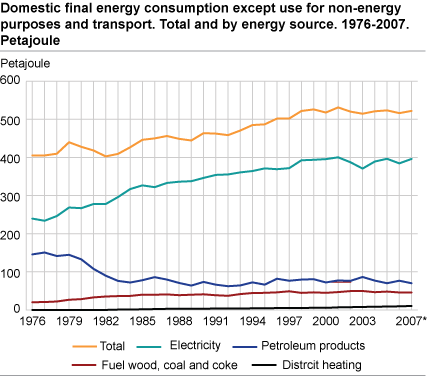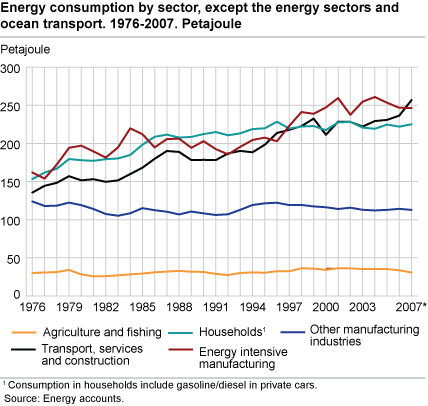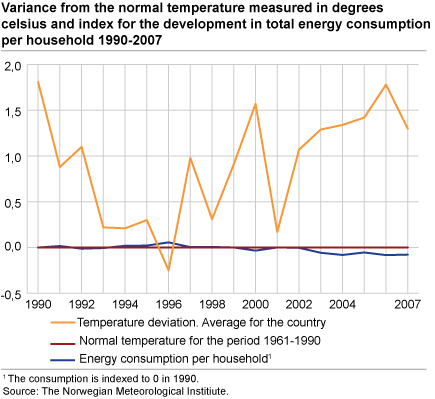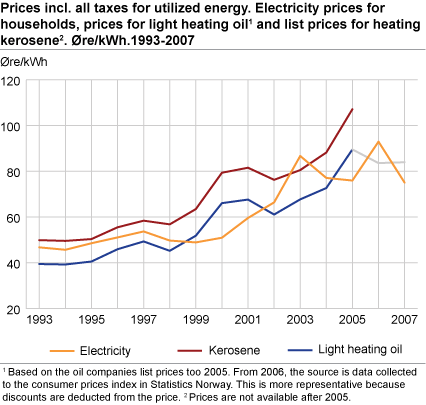Content
Published:
This is an archived release.
More energy to transport
The consumption of energy has never been higher than in 2007. The high consumption was due to high economic activity and more energy consumption in the transport sector.
While the energy consumption in Norway levelled out, or declined in the period 1999-2006, it reached a new top in 2007. From 2006 to 2007, the net domestic consumption of energy rose by 2 per cent, and reached 814 Petajoule (226 TWh), the highest level ever recorded. This was due to a significant increase in the energy consumption to transport, somewhat lower temperature in 2007 than in the previous year, and increased economic activity. The economic growth in 2007 was unusually high, with an increase of 6.1 per cent for mainland Norway (without international shipping and oil- and gas activity).
Energy consumption in transport, manufacturing industries and agriculture accounted for two thirds of the total energy consumption, while services and households accounted for the remaining third. Energy consumption in the first mentioned industries is mainly influenced by economic activity and market conditions, while the energy consumption in households and services (retail trade, hospitals, offices etc.) in addition is much affected by temperature and changes in the population.
We travel and freight more
A consequence of higher economic activity and income is that we travel more and freight more goods, and this fact counters the effect of more fuel efficient vehicles. The transport sector has shown larger increase in energy consumption than all other sectors over the last years. Energy consumption in transport accounted for 23 per cent of the total energy consumption in 1990, but the share had increased to 28 per cent in 2007.
From 2006 to 2007, the consumption of energy by the transport sector increased by almost 5 per cent, mainly due to more use of auto diesel and marine gas oils. It was mainly in road transport and costal shipping that the energy consumption increased. Energy to road- air- and costal transport, which accounts for more than one third of Norway’s total CO2-emissions,is hard to replace with more environmental friendly energy.
Decline in energy consumption to manufacturing industries
The energy consumption in manufacturing industries fell by about 1 per cent from the previous year. This can partly be explained by production stoppage and shutting downs in parts of the energy intensive industry, which lost some of their contracts for cheap electricity prices. This implies that they had to purchase electricity on a commercial basis, which resulted in higher power prices and less profitable production. It was also a decline in the energy consumption in other manufacturing industries.
More energy consumption in households.
Preliminary figures show that the total energy consumption in households rose by about 2 per cent from the previous year. This is mainly due to higher electricity consumption. The consumption of fuel wood and light heating oils fell by about 8 and 15 per cent from the previous year. This development can be explained by a drop in the households’ electricity price from 93 øre/kWh in 2006 to 75 øre/kWh in 2007, all taxes included. The price of light heating oil rose from 6.72 in 2006 to 6.75 in 2007, including all taxes. This corresponds to about 84 øre/kWh in 2007 calculated as utilised energy, and made a change from oil to electricity profitable.
The increase in residential energy consumption can also be explained by population growth.. Calculated consumption per household (total energy consumption divided on the number of households) only rose by 0.4 per cent from the previous year, and this can be explained by lower temperature in 2007.
Higher electricity production
Much precipitation and water from snow melting contributed to a significant increase of about 13 per cent in hydro power production from 2006 to 2007. Also the production of wind power had a high growth. With an increase of 42 per cent from the previous year, the production of wind power reached 0.9 TWh. Still, wind power accounted for only 0.7 per cent of the total electricity production of 138 TWh in 2007. About 98 per cent of the electricity production in Norway comes from hydro power, and due to this, the weather conditions are important. In 2006, we had low precipitation and relatively low electricity production. While we had net exports (exports - imports) of electricity in 2007 on 10 TWh, we had a net import of 1 TWh in 2006.
More energy consumption in oil activity, but lower production
A large share of the energy consumption in Norway is related to production of energy. This is not a part of the net domestic consumption of energy, but is included in the energy sector in the energy balance. Energy consumption and flare burn-off in oil and gas activity rose by 13 per cent from 2006 to 2007, and came to 61 TWh. This was was about the same as the total energy consumption within transport on the mainland. The increase was partly due to start-up problems on the new LNG-plant on Melkøya, that contributed to considerably flare burn-off of natural gas.
Despite higher energy consumption in oil and gas activity, the total production of oil crude oil, condensate, natural gas and NGL declined by about 4 per cent from 2006 to 2007. The trend with declining crude oil production and higher natural gas production continued in 2007. The production of crude oil increased by 7 per cent up, while the production of natural gas decreased by 3 per cent.
Tables:
- Table 1 Energy sources balance sheet for Norway. 2007
- Table 2 Energy balance sheet for Norway. 2007. Petajoule
- Table 3 Energy balance sheet for Norway. 2007. GWh
- Table 4 Energy accounts. Extraction, conversion and use of energy goods. 2007. Preliminary figures
- Table 5 Energy accounts. Use of energy goods outside the energy sectors, by industry. 2007. Preliminary figures
- Table 6 Energy accounts. Extraction, conversion and use of energy goods. 2007. Preliminary figures. PJ
- Table 7 Energy accounts. Extraction, conversion and use of energy goods. 2007. Preliminary figures. GWh
- Table 8 Energy sources balance sheet for Norway. 2006
- Table 9 Energy balance sheet for Norway. 2006. Petajoule
- Table 10 Energy balance sheet for Norway. 2006. GWh
- Table 11 Energy accounts. Extraction, conversion and use of energy goods. 2006
- Table 12 Energy accounts. Use of energy goods outside the energy sectors, by industry. 2006
- Table 13 Energy accounts. Extraction, conversion and use of energy goods. 2006. PJ
- Table 14 Energy accounts. Extraction, conversion and use of energy goods. 2006. GWh
- Table 15 Energy use in Norway 1990-2007, exclusive international maritime transport and commodities used as raw materials. Renewable and not renewable energy. TWh and per cent
- Table 16 Net consumption of individual energy bearers. 1976-2007
- Table 17 Energi balance sheet. 1996-2007*. Petajoule
- Table 18 Percentage share of energy consumption, by individual energy bearers. 1983-2007 .
- Table 19 Energy consumption in households. 1990-2007*
- Table 20 Energy consumption in households. 1990-2007. GWh
- Table 21 Average electricity prices and list prices of selected petroleum products. Excluding and including taxes. 1993-2007
- Table 22 Calculated prices of utilized energy. 1978-2007. Fixed 1998-prices. øre/kWh. All taxes included
- Table 23 Energy balance, total energy 1998-2007. GWh
- Table 24 Supply and use of electricity 1998-2007. GWh
The statistics is now published as Production and consumption of energy, energy balance and energy account.
Additional information
The statistics are published in spring and autumn. The spring publication is preliminary and aggregated to a larger degree, and only includes figures for energy balance. In the autumn publication, tables are also presented for the energy accounts.
Contact
-
Statistics Norway's Information Centre
E-mail: informasjon@ssb.no
tel.: (+47) 21 09 46 42




